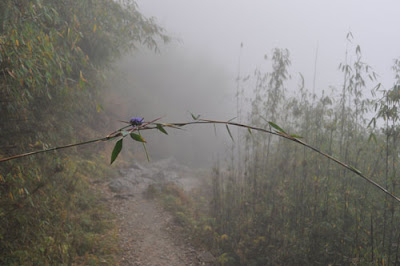 |
| A coconut cookie with peanut butter schmear and a pile of Craisins. We consumed almost a pound of peanut butter in this fashion on the trek to Gossaikund. |
 |
| This is a wedge of yak cheese, bought straight from the maker, on the way back down from Gossaikund. That was a rock solid trip, foodwise. |
Recently Micah (MCC Nepal Rep) organized an All Partner workshop, in which members of all the NGOs who partner (aka receive funding or volunteers) with MCC got together and had a bunch of meetings. The meetings were....well they were meetings. Nuff said.
However, we spent one morning of the workshop doing a service project, in which the twentyish NGO workers volunteered to help paint the courtyard walls of Elim Kids Academy, the school where Kelsey, the other Nepal SALTer, works. It was fun, and nice to get our hands dirty after hours of sitting in the conference room the day before. What happened after the painting was done was hilarious.
The painting only took a half day, and we had a whole afternoon of talking about MCC's financial reporting requirements ahead of us. I needed coffee. I asked Micah if he wanted to go to the 'lil bakery cafe' that I'd seen on the way to the conference place. He invited two of the honchos from the other NGOs, and we walked 100 yards down the dirt alleyway to the shop.
The place was belching christmas flavored smoke. There were probably fifteen hipster youth in the tiny cafe, all smoking "Blacks" clove cigarettes. Adding to the weird, brothelish demeanor of the shop were the two life sized fake skulls on the window sill, a pile of at least 300 packs of those same clove cigarettes in the shelves, and a HUGE poster of a naked woman straddling a motorcycle.
I don't know who decorated that place...but it felt pretty comical for me to be sitting there sipping instant coffee from plastic cups with these classy NGO dudes.
They kinda snickered, but didn't seem too perturbed. We bolted our coffee and left.











































